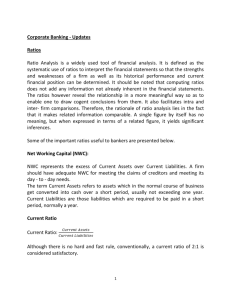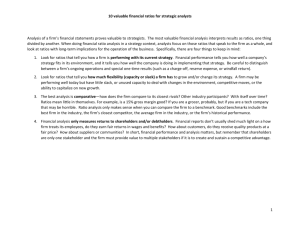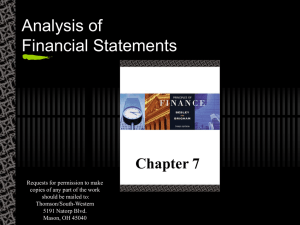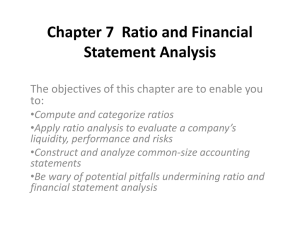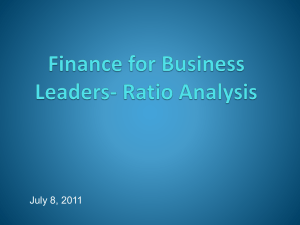Assignment Stage 3 (ASS#3) Ratio Analysis
advertisement
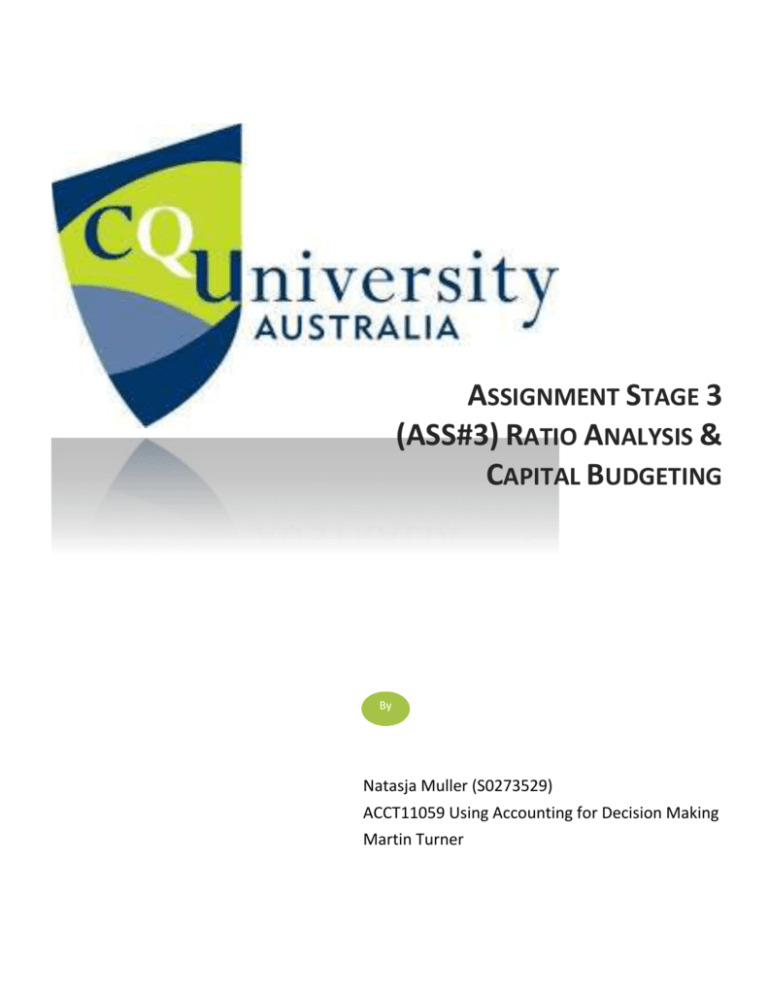
ASSIGNMENT STAGE 3 (ASS#3) RATIO ANALYSIS & CAPITAL BUDGETING By Natasja Muller (S0273529) ACCT11059 Using Accounting for Decision Making Martin Turner STEP 1 Involves you calculating some ratios for your firm (and also its economic profit) and assessing its business performance. As required please find attached Excel spreadsheet where I have calculated my company Sarossa’s ratios using links to my Financial Statements and Restated Financial Statements for the periods 2014, 2013, 2012 and 2011. In analysing the ratios of Sarossa Plc, I have created a timeline below of significant events that have taken place during the period of analysis. I feel it is vital information to establish prior to commencing the ratio analysis of my company as it has morphed from a failed biotechnology company to a successful investment holding and management company. How successful is what I hope to establish through my ratio analysis? Timeline of Sarossa Plc Sarossa Plc Previously operating as Previously operating as Antisoma Plc Sarossa Capital Plc Biotechnology Company Investment Management Company (ceased January 2012) (commenced January 2012) 30 June 2011 30 June 2012 30 June 2013 Investment Management Company (corporate restructure commenced May 2014) 30 June 2014 Current R ATIO A NALYSIS A ratio is a measurement of two different things. Analysing financial ratios compares the value of the size of one number to the size of another number of items found in the financial statements. Studying the trends of these ratios over time we can learn whether there have been improvements or declines within the business and more importantly it gives management an opportunity to make changes accordingly. Comparing ratios in the context of business trends, competitor’s results, industry benchmarks, budgeted results and economic effects will provide useful and meaningful analysis. PROFITABILITY RATIOS gauge the profitability of a business during a specific period. Generally, having a higher value relative to a competitor's ratio or the same ratio from a previous period is indicative that the company is doing well. Net profit margin tells us the profit per dollar after all expenses has been deducted from sales. While net margins will vary from company to company, certain ranges can be expected from industry to industry due to similar business constraints. Return on assets indicates how profitable a company is relative to its total assets. The ROA figure gives investors an idea of how effectively the company is turning the money it has to invest into net income. The higher the ROA number, the better because the company is earning more money on less investment. 2014 1 2013 2012 2011 Net Profit Margin Net profit after tax/sales 153.1% 80.1% 57.0% -5884.3% Return on Assets Net profit after tax/total assets 21.3% 4.1% 2.6% -472.9% COMMENTS ON SAROSSA’S P ERFORMANCE : EFFICIENCY (OR ASSET MANAGEMENT ) RATIOS analyses how effective and efficient a business is managing its assets to produce sales. Total asset turnover ratio measures the amount of sales or revenues generated per dollar of company assets. Generally, if a company can generate more sales with fewer assets it has a higher turnover ratio which could be considered favourably as it is using its assets efficiently. A lower turnover ratio could suggest that the company may not be using its assets optimally. The results however should be considered across the industry standards as this can vary greatly and influence the outcomes. Improvement in the ratios usually translate to improved profitability. Total Asset Turnover Ratio Sales/total assets 2014 2013 2012 2011 0.14 0.05 0.05 0.08 COMMENTS ON SAROSSA’S P ERFORMANCE : LIQUIDITY RATIOS measure a company's ability to pay off its short-terms debts obligations. Generally, the higher the value of the ratio, the larger the margin of safety that the company possesses to cover short-term debts. Current ratio expresses the extent to which the current liabilities of a business are covered by its current assets. Commonly, the higher the current ratio the better a company is able to cover its debts. Although an abnormally high value of current ratio may indicate existence of idle or underutilised resources in the company. 2014 Current Ratio Current assets/current liabilities COMMENTS ON SAROSSA’S P ERFORMANCE : 2 (52.97) 2013 (4.28) 2012 (7.99) 2011 (6.90) FINANCIAL STRUCTURE RATIOS provide insight into how risky a company is. A company more heavily financed by debt is usually poses greater risk and is considered to be highly leveraged. Debt-to-equity ratio is a measure of the relationship between the capital contributed by creditors and the capital contributed by shareholders. It also shows the extent to which shareholders' equity can fulfill a company's obligations to creditors in the event of a liquidation. Equity ratio quantifies the proportion of the total assets that are financed by shareholders and not creditors or debt. A high equity ratio provides security to shareholders in the event a company is liquidated, since most of the assets are financed by equity and not by debt. As long as the company earns a rate of return on assets that is greater than the interest rate paid to creditors. A low equity ratio is considered favourable. 2014 2013 2012 2011 Debt/Equity Ratio Debt/equity -0.7% -13.3% -13.2% -16.9% Equity Ratio Equity/total assets 99.3% 88.2% 88.4% 85.5% COMMENTS ON SAROSSA’S P ERFORMANCE : MARKET RATIOS evaluate the current market price of ordinary shares against an indicator of the company's ability to generate profits or assets held by the company. Earnings per share (EPS) is the amount of profit put aside by a company for each outstanding share of common stock. It is simply a ratio that measures a company's earnings (profit after tax) divided by the number of ordinary shares. This can be used to measure a company's profit performance over time. It also shows the potential for paying out dividends to shareholders. Dividends per share (DPS) evaluates the total number of dividends declared for each portion of issued ordinary shares. Declared dividends are the portion of the company’s profit that is to be paid to the shareholder. Generally, if dividends per share drop it is a signal that the company may not be doing so well financially. If dividends per share go up it is often a signal that the firm is performing well financially. Price earnings ratio measures a company's current share price compared to its per-share earnings. It determines if a company's share price is over or undervalued. High P/E ratios are typically growth shares. 2014 Earnings per Share (EPS) Net profit after tax/number of issued 2013 2012 2011 0.58 0.10 0.06 (10.84) 0.00 0.00 0.00 0.00 ordinary shares Dividends per Share (DPS) Dividends/number of issued ordinary shares 3 Price Earnings Ratio Market price per share/earnings 3.24 19.22 31.71 0.00 per share COMMENTS ON SAROSSA’S P ERFORMANCE : R ATIOS B ASED ON R EFORMULATED F INANCIAL S TATEMENTS Return on Equity (ROE) is a measure of profitability that calculates how many dollars of profit a company generates with each dollar of shareholders' equity. Return on Equity (ROE) Comprehensive Income/shareholders' equity 2014 2013 21.42% 4.60% 2012 2.92% 2011 -556.04% COMMENTS ON SAROSSA’S P ERFORMANCE : Return on Net Operating Assets (RNOA) focuses attention on only those assets used to generate revenue. Operating assets are tangible property used in production, such as real estate and machinery. Net working capital is calculated by taking the company's current assets minus its current liabilities. Once measured, a common outcome is that management works to minimise all of the other assets on the books that are not contributing to revenue. The higher the return, the better the profit performance for the company. Return on Net Operating Assets (RNOA) Operating income after tax (OI)/net operating assets (NOA) 2014 2013 2012 33.16% 6.91% 3788.62% 2014 2013 2012 2011 -29675.52% COMMENTS ON SAROSSA’S P ERFORMANCE : Net Borrowing Cost (NBC) Net Borrowing Cost (NBC) Net financial expenses after tax (NFE)/net financial obligations (NFO) COMMENTS ON SAROSSA’S P ERFORMANCE : 4 2011 Profit Margin (PM) Profit Margin (PM) Operating income after tax (OI)/sales 2014 2013 2012 152.95% 59.33% 2014 2013 2012 22% 12% 5085% 74.51% 2011 -5919.99% COMMENTS ON SAROSSA’S P ERFORMANCE : Asset Turnover (ATO) Asset Turnover (ATO) Sales/net operating assets (NOA) 2011 501% COMMENTS ON SAROSSA’S P ERFORMANCE : E CONOMIC P ROFIT 2014 Economic Profit (RNOA - cost of capital) x net operating assets (NOA) COMMENTS ON SAROSSA’S P ERFORMANCE : 5 2,574.5 2013 (206.5) 2012 491.2 2011 (69,761.0) STEP 2 Involves you developing a capital investment decision for your firm and completing a simple analysis of this decision using Payback Period, NPV and IRR. 6 STEP 3 Involves you providing (and receiving) feedback to three other students in our course on their draft ASS#3. FEEDBACK - JOHN PLAYFORD Step 1 Step 2 Overall JOHN’S FEEDBACK OF MY DRAFT MY THOUGHTS ON JOHN’S FEEDBACK FEEDBACK - JODIE SHERMAN Step 1 Step 2 Overall JODIE’S FEEDBACK OF MY DRAFT MY THOUGHTS ON JODIE’S FEEDBACK FEEDBACK - JORDAN NOONAN Step 1 Step 2 Overall JORDAN’S FEEDBACK OF MY DRAFT MY THOUGHTS ON JORDAN’ S FEEDBACK 7




